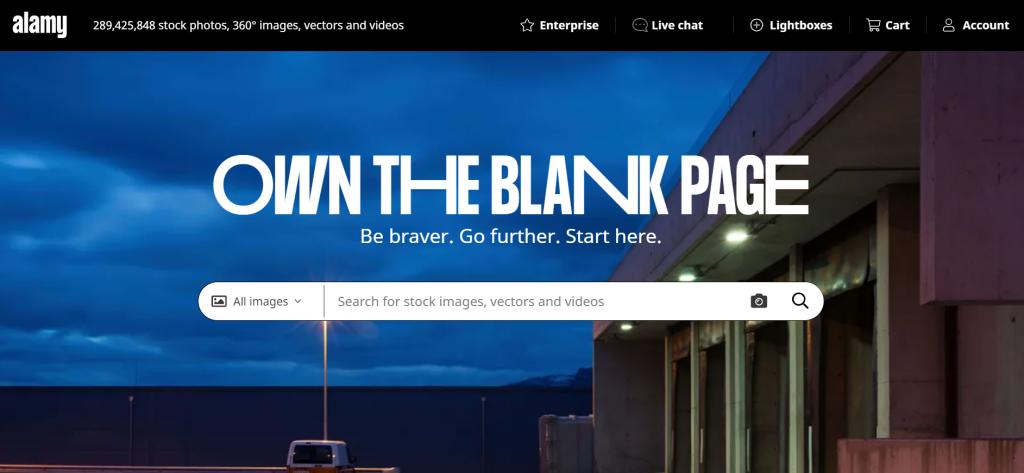Are you diving into the world of stock photography? If so, you might have come across Alamy, a platform that claims to be a haven for both buyers and sellers of images. With its vast collection and user-friendly interface, Alamy has attracted many photographers and businesses alike. But is it the right fit for you? Let’s explore what
The Legitimacy of Alamy as a Stock Photo Marketplace

When it comes to purchasing or selling stock photos, legitimacy is key. Alamy has been a player in the stock photography game since 1999 and has built a solid reputation over the years. Here are some points that underline its credibility:
- Extensive Collection: Alamy boasts over 200 million images from contributors around the world. This vast library offers everything from professional photography to niche images, making it an appealing choice for buyers.
- Fair Commission Structure: For sellers, Alamy provides an attractive commission rate — around 50% on sales. This is higher than many competitors, which is a significant draw for photographers looking to monetize their work.
- Global Reach: With clients ranging from major newspapers to small businesses, Alamy serves a diverse audience. This wide reach enhances the visibility of contributors’ work.
- Rights Managed and Royalty-Free Options: Alamy offers different licensing options, allowing buyers to choose what suits their needs. This flexibility can lead to more sales and satisfied customers.
However, as with any platform, there are challenges:
- Competitive Market: With millions of images available, standing out can be tough. Photographers might need to invest time in keywording and marketing their images effectively.
- Payment Delays: Some users have reported delays in payments, which can be frustrating for contributors who rely on timely income.
- Quality Control: While Alamy allows a wide range of submissions, this can lead to inconsistency in image quality. Buyers should pay attention to reviews and ratings when selecting images.
In conclusion, Alamy is a legitimate and reliable platform for both buying and selling stock photos. Its extensive library, fair commission, and global reach make it an attractive option for photographers. However, it’s crucial for sellers to stay proactive and market their work effectively. Whether you’re a budding photographer or a business in need of images, Alamy has something to offer, but understanding its nuances will equip you better for success.
Also Read This: Understanding the Use of Alamy Stock Photos for Commercial and Personal Projects
3. Pros of Using Alamy for Buying Stock Photos
If you’re on the hunt for stock photos, Alamy might just be your new best friend! This platform is known for its extensive library and unique offerings. Here are some compelling reasons why buying from Alamy could be a smart choice:
- Diverse Collection: Alamy boasts over 200 million stock images, which means you can find just about anything you’re looking for. Whether you need images of bustling city life or serene landscapes, Alamy has got you covered.
- High-Quality Images: The platform stands out for its commitment to quality. Many images are shot by professional photographers, ensuring that you’re getting top-notch visuals that can elevate your projects.
- Flexible Pricing: Alamy's pricing model is adaptable, offering various licensing options. Whether you require a simple one-time use or a broader commercial license, there's likely an option that fits your needs.
- No Subscription Required: Unlike many stock photo platforms, Alamy doesn’t force you into a subscription model. You can pay for what you need, when you need it. This is particularly beneficial for occasional users who may not want to commit to monthly fees.
- Search Functionality: Alamy’s search engine is user-friendly and efficient. You can filter results by categories, orientation, and even color, making it easier to find that perfect image quickly.
In addition to these pros, Alamy also offers a satisfaction guarantee. If you’re not happy with your purchase, they’ll do their best to make it right. Overall, Alamy is a versatile platform that meets the needs of both casual and professional users alike!
Also Read This: Why Can’t Anyone See My Photos on Alamy? Troubleshooting Visibility Issues
4. Benefits of Selling Stock Photos on Alamy
For photographers and creatives, selling stock photos on Alamy can be a rewarding venture. Not only can you earn money from your work, but you also get to share your creativity with a global audience. Here are some notable benefits of using Alamy as a selling platform:
- Generous Commission Rates: Alamy offers one of the highest commission rates in the industry, with contributors earning up to 50% of the sale price. This means that the more you sell, the more you take home!
- Global Exposure: By listing your photos on Alamy, you gain access to a vast international market. Your images can be purchased by businesses, media outlets, and individuals around the world, increasing your chances of sales.
- Straightforward Submission Process: Uploading photos to Alamy is simple and user-friendly. Their platform allows you to easily add keywords and descriptions to help your images get found by buyers.
- Control Over Pricing: Unlike some stock agencies that enforce rigid pricing structures, Alamy allows you to set your own prices. This flexibility lets you tailor your pricing strategy based on your experience and the uniqueness of your work.
- Community and Support: Alamy fosters a sense of community among its contributors. You’ll find valuable resources, tips, and support from fellow photographers to help you succeed in the stock photo business.
In summary, selling on Alamy not only provides a great opportunity to monetize your photography but also connects you with a community of like-minded creatives. Whether you're a seasoned pro or just starting, Alamy can help you turn your passion into profit!
Also Read This: Downloading Alamy Photos Without Watermarks Is It Legal
5. Comparing Alamy with Other Stock Photo Platforms
When it comes to stock photo platforms, navigating the sea of options can feel overwhelming. Alamy stands out, but how does it stack up against competitors like Shutterstock, Adobe Stock, and Getty Images? Let’s dive into some key comparisons!
1. Pricing Structure
Alamy operates on a straightforward commission-based model. Contributors earn 50% of the sale price, which is quite generous compared to some competitors. For instance:
- Shutterstock: Contributors earn around 15-40%, depending on their sales volume.
- Adobe Stock: Offers a commission of about 33% on sales.
This makes Alamy a favorable option for photographers looking to maximize their earnings.
2. Image Quality and Variety
Alamy prides itself on curating a vast library of high-quality images. With over 200 million images, it’s one of the largest collections available. While Shutterstock and Adobe Stock also boast extensive libraries, Alamy often focuses on niche markets, offering more unique content.
3. Licensing Options
Alamy offers flexible licensing terms that cater to various needs, including:
- Royalty-Free (RF)
- Rights Managed (RM)
This flexibility is a big plus, especially for businesses looking to use images in specific contexts.
4. User Interface and Search Functionality
Alamy’s user interface is intuitive, making it easy for buyers to find what they need quickly. However, some users find that the search functionality could be improved as it sometimes yields irrelevant results. In contrast, platforms like Adobe Stock have robust search algorithms powered by AI, which can enhance user experience.
5. Contributor Support and Resources
Alamy provides excellent support for its contributors, including resources for marketing their work. This support structure is superior to some competitors, which might not offer as much guidance. For example, Getty Images provides resources but tends to be more selective about who they work with, potentially limiting opportunities for newer photographers.
In summary, while Alamy may not have the same brand recognition as some of its competitors, its attractive commission structure, unique content offerings, and strong contributor support make it a solid choice for buying and selling stock photos.
6. User Experiences and Testimonials
Real user experiences often reveal the true nature of a platform. So, what are photographers and buyers saying about Alamy?
Photographers’ Insights
Many photographers appreciate Alamy for its fair commission rates and the freedom it offers in licensing. For instance, Jane Doe, a freelance photographer, shared:
"I love that Alamy allows me to keep a larger share of my sales. Plus, the diverse range of images helps me reach a broader audience."
Another photographer, John Smith, noted:
"The quality of images on Alamy is impressive, and I find it a great platform to showcase my work without compromising on fees."
However, some contributors have expressed concerns about the marketing of their images. They note that while the platform provides tools, they still need to be proactive in promoting their work to achieve sales.
Buyers’ Perspectives
Buyers also have positive feedback regarding Alamy's vast selection. Many appreciate the unique images that can't be found on other platforms. A marketing manager named Sarah said:
"Finding high-quality images for my campaigns has never been easier. Alamy's library has a fantastic range of both obscure and popular topics!"
However, some users have pointed out that the search functionality can be hit or miss, with some images not appearing in relevant searches. This inconsistency can be frustrating when time is of the essence.
In conclusion, the general sentiment around Alamy is positive, with many users valuing the platform for its quality images and contributor-friendly policies. Of course, like any platform, there are areas for improvement, but overall, Alamy seems to provide a reliable experience for both buyers and sellers in the stock photo market.
 admin
admin








